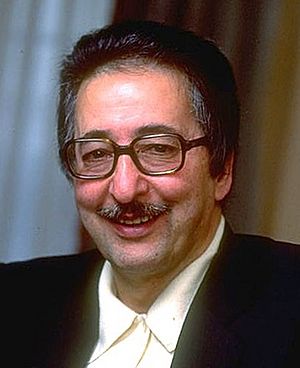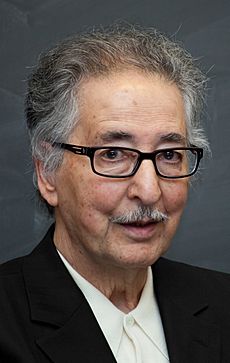Abolhassan Banisadr facts for kids
Quick facts for kids
Abolhassan Banisadr
|
|
|---|---|
| ابوالحسن بنیصدر | |

Banisadr in 1980
|
|
| 1st President of Iran | |
| In office 4 February 1980 – 22 June 1981 |
|
| Supreme Leader | Ruhollah Khomeini |
| Prime Minister | Mohammad-Ali Rajai |
| Preceded by | Office established |
| Succeeded by | Mohammad-Ali Rajai |
| Head of Council of the Islamic Revolution | |
| In office 7 February 1980 – 20 July 1980 |
|
| Preceded by | Mohammad Beheshti |
| Succeeded by | Office abolished |
| Minister of Foreign Affairs Acting |
|
| In office 12 November 1979 – 29 November 1979 |
|
| Appointed by | Council of the Revolution |
| Preceded by | Ebrahim Yazdi |
| Succeeded by | Sadegh Ghotbzadeh |
| Minister of Finance | |
| In office 17 November 1979 – 10 February 1980 |
|
| Appointed by | Council of the Revolution |
| Preceded by | Ali Ardalan |
| Succeeded by | Hossein Namazi |
| Member of the Assembly of Experts for Constitution | |
| In office 15 August 1979 – 15 November 1979 |
|
| Constituency | Tehran Province |
| Majority | 1,752,816 (69.4%) |
| Personal details | |
| Born | 22 March 1933 Hamadan, Imperial State of Iran |
| Died | 9 October 2021 (aged 88) Paris, France |
| Political party | Independent |
| Other political affiliations |
|
| Spouse |
Ozra Hosseini
(m. 1961) |
| Children | 3 |
| Alma mater | University of Tehran Sorbonne University |
| Signature |  |
Seyyed Abolhassan Banisadr (Persian: سید ابوالحسن بنیصدر; born 22 March 1933 – died 9 October 2021) was an Iranian politician and writer. He became the first president of Iran after the Iranian Revolution in 1979. This revolution ended the old system of monarchy (rule by a king or queen). Banisadr served as president from February 1980 until June 1981, when he was removed from office by the parliament. Before becoming president, he was the minister of foreign affairs for a short time. After leaving Iran, he lived in France and wrote many books about his experiences and his views on the Iranian government.
Contents
Early Life and Education
Abolhassan Banisadr was born on 22 March 1933 in Hamadan, a city in Iran. His father was an ayatollah, which is a high-ranking religious leader in Shia Islam. His father was also close to Ruhollah Khomeini, who later became Iran's Supreme Leader.
Banisadr studied law, theology (the study of religion), and sociology at the University of Tehran. In the 1960s, he continued his studies in finance and economics at the Sorbonne University in France. In 1972, he met Ayatollah Khomeini for the first time at his father's funeral in Iraq.
During the early 1960s, Banisadr took part in student protests against the Shah (the former king of Iran). He was put in prison twice and was hurt during an uprising in 1963. This led him to leave Iran and go to France. There, he joined the Iranian resistance group led by Khomeini. He became one of Khomeini's important advisors. In February 1979, Banisadr returned to Iran with Khomeini as the revolution began. He also wrote a book about Islamic finance called Eghtesad Tohidi.
Political Career
After the Iranian Revolution, Banisadr took on several important roles. On 4 February 1979, he became the deputy minister of finance. He was also part of the revolutionary council that was guiding the country.
Later, he was appointed as the minister of finance. Then, on 12 November 1979, he became the foreign minister.
Banisadr was elected president of Iran on 25 January 1980. He won with a large majority of the votes. He officially became president on 4 February. It's important to know that Ayatollah Khomeini remained the Supreme Leader of Iran. This meant Khomeini had the power to remove the president from office. The ceremony where Banisadr became president was held at the hospital where Khomeini was recovering.
Banisadr was not a religious cleric. Khomeini had said that religious leaders should not hold government positions. During the Iran–Iraq War, Banisadr was made the acting commander-in-chief of the armed forces by Khomeini on 10 June 1981.

Removal from Office
On 21 June 1981, the Majlis (Iran's Parliament) voted to remove Banisadr from his position as president. This process is called impeachment. The reason given was that he was acting against the religious leaders in power, especially Mohammad Beheshti, who was the head of the judicial system. It seems that Ayatollah Khomeini himself encouraged this decision, and he signed the order the very next day.
Before Khomeini signed the impeachment papers, the Revolutionary Guard took control of the Presidential buildings. They also arrested writers from a newspaper that supported Banisadr. In the days that followed, some of Banisadr's close friends were executed. Ayatollah Hussein-Ali Montazeri was one of the few government officials who continued to support Banisadr, but he soon lost his own powers.
At the same time, the Iranian government made all political parties illegal, except for the Islamic Republican Party. Members of other parties were arrested and put in prison.
Banisadr went into hiding for a few days before he was officially removed from office. He was protected by a group called the People's Mujahedin of Iran (PMOI). He tried to form an alliance with other groups who were against Khomeini's rule. However, after a PMOI member was executed, Banisadr and the PMOI leader decided it was no longer safe for them to stay in Iran.
Banisadr believed that his removal from office was a coup d'état, meaning a sudden and illegal takeover of power, against democracy in Iran. He had asked for a public vote, or referendum, to solve the political disagreements in the country.
Escape and Life in Exile
After being removed from office on 21 June 1981, Banisadr went into hiding in western Iran. On 29 July, Banisadr and Massoud Rajavi (the PMOI leader) secretly left Iran on an Iranian Air Force plane. The plane flew to Paris, France. To avoid being recognized, Banisadr had shaved his eyebrows and mustache and wore a disguise.
Banisadr and Rajavi were given political asylum in Paris, which meant they could live there safely. However, they were asked not to carry out activities against Khomeini's government from France. Banisadr, Rajavi, and the Kurdish Democratic Party then formed the National Council of Resistance of Iran in Paris in October 1981. However, Banisadr and Rajavi soon disagreed and went their separate ways. Banisadr did not support the armed opposition that Rajavi started.
'My Turn to Speak'
In 1991, Banisadr released an English version of his book, My Turn to Speak: Iran, the Revolution and Secret Deals with the U.S. In this book, Banisadr wrote about his experiences and his views on the Iranian Revolution. He made some claims about secret dealings between the Ronald Reagan presidential campaign and Iranian leaders. He also claimed that other important figures were involved in plots related to the Iran hostage crisis and the Iran–Iraq War.
Reviewers described the book as interesting but sometimes hard to follow. They noted that it contained many sensational claims but lacked detailed proof.
His Views
In a 2008 interview, Banisadr stated that Khomeini was responsible for some of the violence that came from the Muslim world. He also claimed that the promises Khomeini made before the revolution were not kept afterwards. In July 2009, Banisadr openly criticized the Iranian government's actions after the disputed presidential election. He said that the government was "holding on to power only by means of violence and terror." He also accused its leaders of becoming wealthy while other Iranians suffered.
He believed that the government had lost its right to rule because of the protests and the violent actions taken against them.
Personal Life and Death
From 1981 onwards, Banisadr lived in Versailles, a town near Paris, France. His home was closely guarded by French police. Banisadr's daughter, Firoozeh, married Massoud Rajavi in Paris after they went into exile. However, they later divorced, and the alliance between Banisadr and Rajavi also ended.
After a long illness, Abolhassan Banisadr passed away at a hospital in Paris on 9 October 2021. He was 88 years old. He is buried in the cemetery of Gonards in Versailles.
Books
- Touhid Economics, 1980
- My Turn to Speak: Iran, the Revolution and Secret Deals with the U.S., 1991. This was a translation of his 1989 French book, Le complot des ayatollahs.
- Le Coran et le pouvoir: principes fondamentaux du Coran, 1993
- Dignity in the 21st Century, with Doris Schroeder, 2008
See Also
 In Spanish: Abolhasán Banisadr para niños
In Spanish: Abolhasán Banisadr para niños
- October Surprise conspiracy theory


